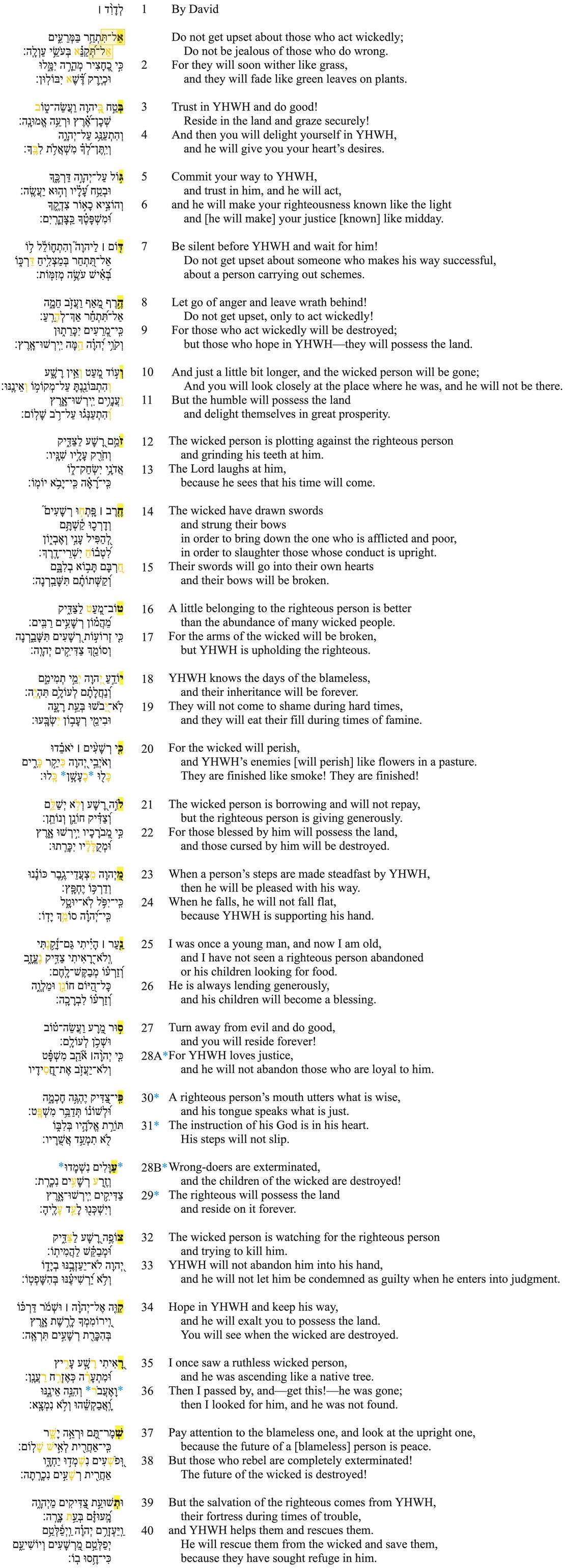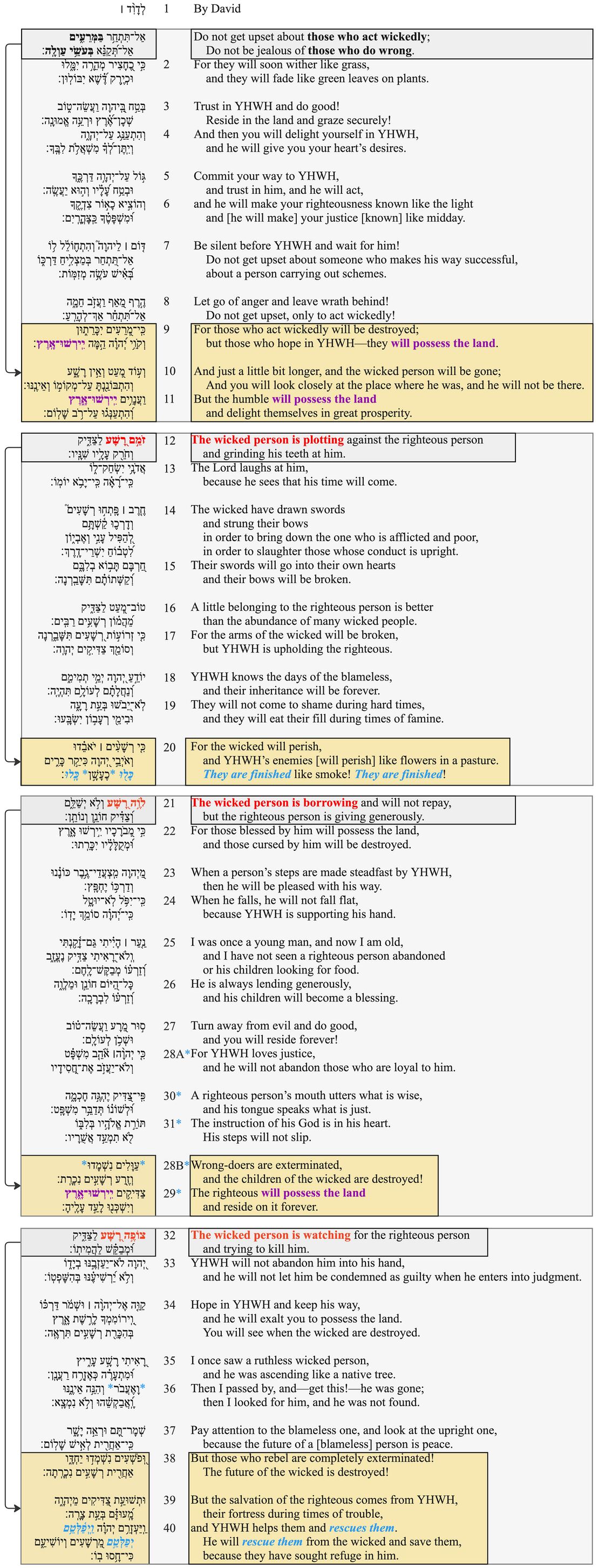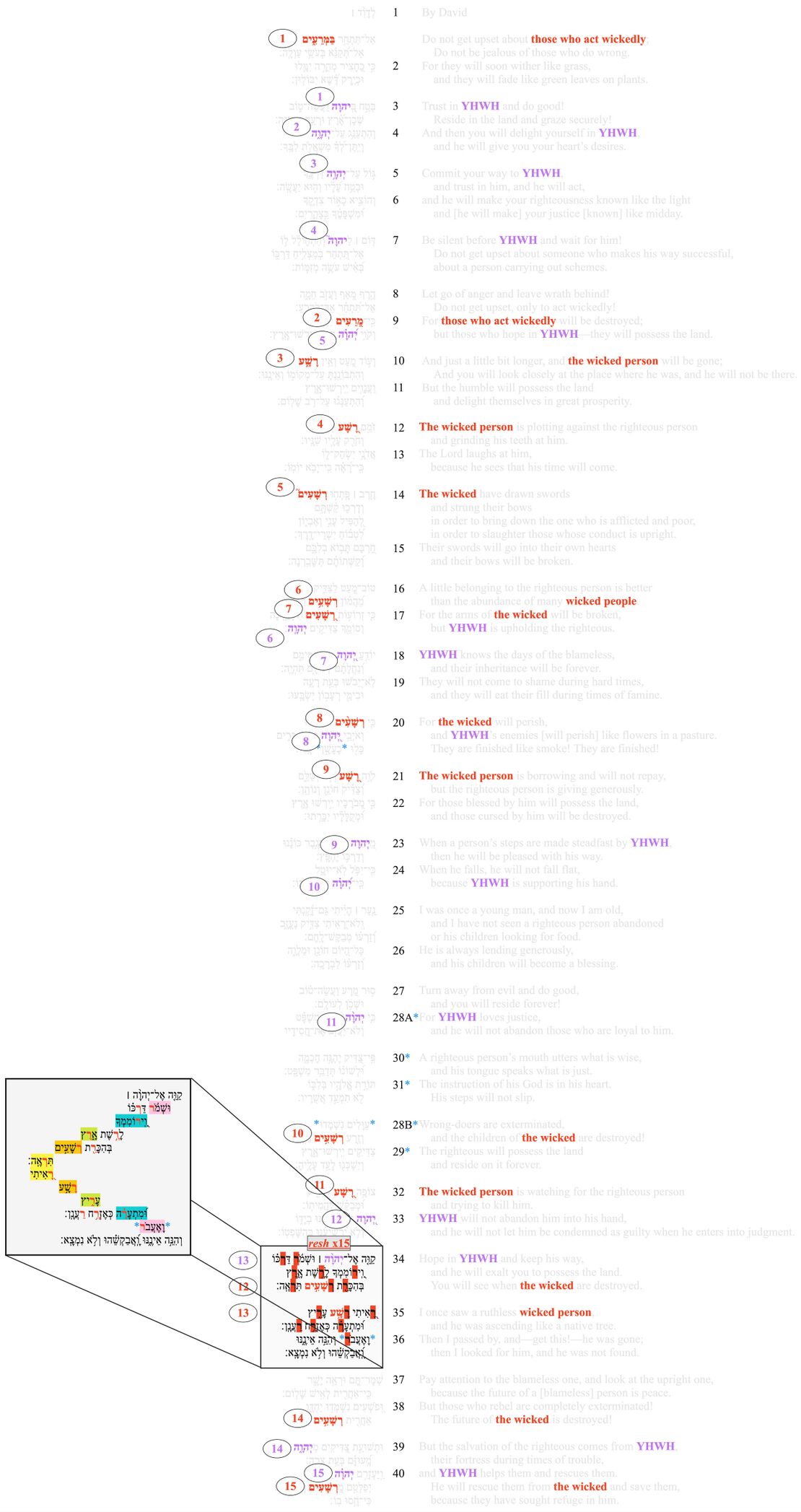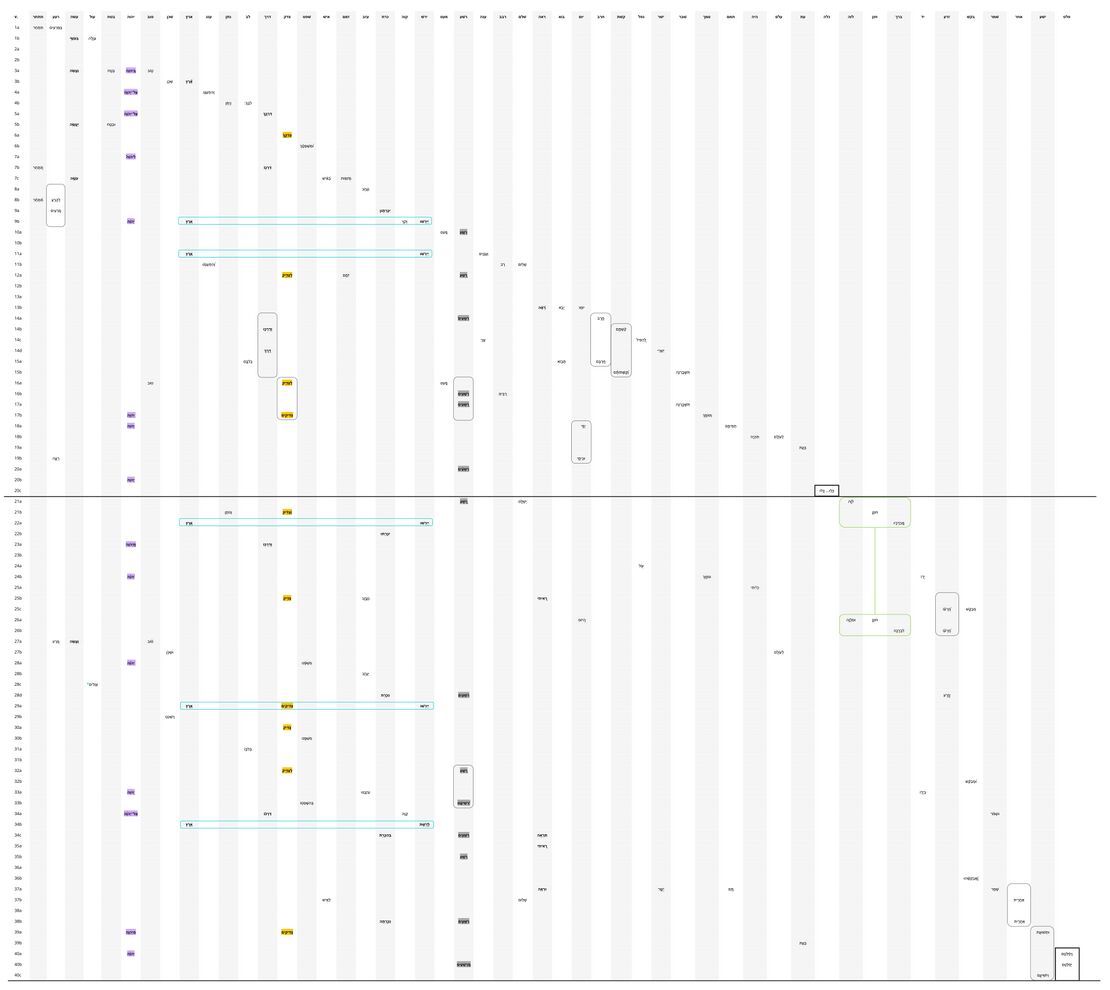Psalm 37 Poetic Features
Poetic Features
In poetic features, we identify and describe the “Top 3 Poetic Features” for each Psalm. Poetic features might include intricate patterns (e.g., chiasms), long range correspondences across the psalm, evocative uses of imagery, sound-plays, allusions to other parts of the Bible, and various other features or combinations of features. For each poetic feature, we describe both the formal aspects of the feature and the poetic effect of the feature. We assume that there is no one-to-one correspondence between a feature’s formal aspects and its effect, and that similar forms might have very different effects depending on their contexts. The effect of a poetic feature is best determined (subjectively) by a thoughtful examination of the feature against the background of the psalm’s overall message and purpose.
From A to Z
If an emendation or revocalization is preferred, that emendation or revocalization will be marked in the Hebrew text of all the visuals.
| Emendations/Revocalizations legend | |
|---|---|
| *Emended text* | Emended text, text in which the consonants differ from the consonants of the Masoretic text, is indicated by blue asterisks on either side of the emendation. |
| *Revocalized text* | Revocalized text, text in which only the vowels differ from the vowels of the Masoretic text, is indicated by purple asterisks on either side of the revocalization. |
Feature
Psalm 37 is an acrostic poem: each strophe begins with a successive letter of the Hebrew alphabet.
In addition to this basic acrostic structure, there are other, more subtle ways, in which the poem plays with the alphabetic sequence:
- - The first two lines of the poem each begin with the letters אלת—the first letter, middle, and final letters of the alphabet.
- - Some of the strophes not only begin with the next letter of the alphabet, they repeat that letter in poetic ways. E.g.,
- - Prolonged alliterative sequences:
- - כִּיקַ֣ר כָּרִ֑ים כָּל֖וּ כֶעָשָׁ֣ן כָּֽלוּ׃ (v. 20bc)
- - רָ֭אִיתִי רָשָׁ֣ע עָרִ֑יץ וּ֝מִתְעָרֶ֗ה כְּאֶזְרָ֥ח רַעֲנָֽן ׃וָאֶעֲבֹר (vv. 35-36)
- - see also waw strophe (vv. 10-11)
- - Multiple words beginning with the letter to open the strophe:
- - בְּטַ֣ח בַּֽ֭יהוָה (v. 3a)
- - יוֹדֵ֣עַ יְ֭הוָה יְמֵ֣י (v. 18a)
- - מֵ֭יְהוָה מִֽצְעֲדֵי (v. 23a)
- -רָ֭אִיתִי רָשָׁ֣ע (v. 35a)
- -See also חֶ֤רֶב ׀ פָּֽתְח֣וּ (v. 14a); טוֹב־מְ֭עַט (v. 16a) (v. 16a)
- - Repeating the letter at the end of the strophe (inclusio):
- - בְּטַ֣ח...לִבֶּֽךָ (vv. 3-4)
- - יוֹדֵ֣עַ...יִשְׂבָּֽעוּ (vv. 18-19)
- - כִּ֤י...כָּֽלוּ (v. 20)
- - ס֣וּר...חֲ֭סִידָיו (vv. 27-28A)
- - עַוָּלִים...לָעַ֣ד עָלֶֽיהָ (vv. 28B-29)
- - Prolonged alliterative sequences:
Effect
The alphabet is a symbol of completeness (see Gottwald 1954, 23-32; cf. Soll 2001, I.58-59; Watson 2001, 197-199). In an acrostic poem, the poet takes a topic (e.g., Torah [Ps. 119], or the virtuous woman [Prov. 31]) and expounds on it completely (i.e., from every angle necessary to gain a sufficient understanding), so that the reader walks away with a high-resolution image of the topic (i.e., he/she understands it “from A to Z”). In Psalm 37, the topic is How to respond to the success of the wicked.
(Interestingly, the Babylonian Theodicy [c. 1000 BC], which deals with a similar theme, is also an acrostic poem, in which the sequence of stanza-initial letters form a message that serves to identify the author [see COS 1.154]).
The wicked is plotting... but not for long
If an emendation or revocalization is preferred, that emendation or revocalization will be marked in the Hebrew text of all the visuals.
| Emendations/Revocalizations legend | |
|---|---|
| *Emended text* | Emended text, text in which the consonants differ from the consonants of the Masoretic text, is indicated by blue asterisks on either side of the emendation. |
| *Revocalized text* | Revocalized text, text in which only the vowels differ from the vowels of the Masoretic text, is indicated by purple asterisks on either side of the revocalization. |
Feature
Psalm 37 consists of four sections (see Poetic Structure).
Each section begins by acknowledging the present reality of the wicked and their attempts to harm the righteous:
- - "those who act wickedly... those who do wrong" (v. 1)
- - "the wicked is plotting..." (v. 12)
- - "the wicked is borrowing..." (v. 21)
- - "the wicked is watching..." (v. 32)
The beginnings of the last three sections are especially similar to each other: each begins with a ms participle following by the subject רָשָׁע ("wicked person").
Each section ends with the destruction of the wicked and the salvation of the righteous:
- - "...the humble will possess the land" (vv. 9-11)
- - "The wicked... are finished... They are finished!" (v. 20)
- - "...the righteous will possess the land"" (vv. 28B-29)
- - "YHWH rescues them... He will rescue them..." (vv. 39-40)
These endings exhibit a pattern. The first and third endings repeat the phrase יִירְשׁוּ אָרֶץ ("they will possess the land"). The second and fourth endings repeat words in close proximity to one another (the only example of this kind of repetition in the psalm): "finished...finished!" (v. 20); "rescues... rescues" (vv. 39-40). It is also worth noting that each of the last three sections ends with qatal verbs to describe the destruction of the wicked as an event that is as good as done: "they are finished!" (v. 20); "wrongdoers are exterminated!" (v. 28B); "those who rebel are completely exterminated!" (v. 38).
Effect
The four sections of the psalm represent four cycles of the same story: In the present, people act wickedly without immediate consequences, but in the end, the wicked will be completely destroyed and the righteous will possess the land. This story constitutes the heart of the psalm's message, and it means that YHWH's people should wait patiently for him. Things might look bleak in the present, but YHWH will make everything right in the end.
Get this!
If an emendation or revocalization is preferred, that emendation or revocalization will be marked in the Hebrew text of all the visuals.
| Emendations/Revocalizations legend | |
|---|---|
| *Emended text* | Emended text, text in which the consonants differ from the consonants of the Masoretic text, is indicated by blue asterisks on either side of the emendation. |
| *Revocalized text* | Revocalized text, text in which only the vowels differ from the vowels of the Masoretic text, is indicated by purple asterisks on either side of the revocalization. |
Feature
(Note: The following feature is based on the article, Michael Lehmann and Nachman Levine, “An Alliterative-Typographical Device in Psalm 37: Divine Destruction of the Wicked, Enacted in Real Time,” Journal for the Study of the Old Testament 45, no. 3 (2021): 407–421.)
Verses 34-36 contain a 15-word sequence of words that contain the letter resh. Such a long sequence of resh words is unparalleled in the Psalter. And in at least one of the words (מִתְעָרֶה), the letter resh is a substitute for the expected letter lamed (מִתְעַלֶּה; see The Text and Meaning of Psalm37:35b). The resh sequence comes to an end with the words "and—get this!—he was gone" (v. 36).
One of the most repeated words in Ps 37 is the word "wicked" (רָשָׁע, plural: רְשָׁעִים), which occurs 13 times (vv. 10, 12, 14, 16, 17, 20, 21, 28B, 32, 34, 35, 38, 40). Another word used to refer to the wicked in this psalm is the word מְרֵעִים, which occurs two times (vv. 2, 9). Although there are other words in Ps 37 that refer to the wicked, these are the only words for wicked that contain the letter resh. Thus, the psalm uses 15 resh words to refer to the wicked.
The psalm also uses the divine name (יהוה) a total of 15 times.
The resh sequence in vv. 34-36 has a chiastic structure, based on a combination of semantics, syntax, and sound:
- a. קַוֵּ֤ה אֶל־יְהוָ֨ה ׀ (no resh words)
- b. וּשְׁמֹ֬ר דַּרְכּ֗וֹ (verb with waw)
- c. וִֽ֭ירוֹמִמְךָ (image of height: "exalt")
- d. לָרֶ֣שֶׁת אָ֑רֶץ (sounds: guttural, resh, tsade)
- e. בְּהִכָּרֵ֖ת רְשָׁעִ֣ים ("wicked")
- f. תִּרְאֶֽה ("see")
- f. רָ֭אִיתִי ("see")
- e. רָשָׁ֣ע ("wicked")
- e. בְּהִכָּרֵ֖ת רְשָׁעִ֣ים ("wicked")
- d. עָרִ֑יץ (sounds: guttural, resh, tsade)
- d. לָרֶ֣שֶׁת אָ֑רֶץ (sounds: guttural, resh, tsade)
- c. וּ֝מִתְעָרֶ֗ה כְּאֶזְרָ֥ח רַעֲנָֽן׃ (image of height: "ascending")
- c. וִֽ֭ירוֹמִמְךָ (image of height: "exalt")
- b. וָאֶעֲבֹר (verb with waw)
- b. וּשְׁמֹ֬ר דַּרְכּ֗וֹ (verb with waw)
- a. וְהִנֵּ֣ה אֵינֶ֑נּוּ וָֽ֝אֲבַקְשֵׁ֗הוּ וְלֹ֣א נִמְצָֽא׃ (no resh words)
Effect
The subtle chiasm in vv. 34-36 encourages us to read these verses as a unit. When we do, we are immediately struck by the sequence of resh words. The letter resh in vv. 34-36, occurring in 15 consecutive words, symbolizes the wicked (רְשָׁעִים / מְרֵעִים), who are referred to 15 times in the psalm with resh words. The preponderance of resh words in vv. 34-36 contributes to a feeling that the presence of the wicked is overwhelming and never-ending. The wicked are like grass (v. 2) that grows up everywhere, and they are like native trees (v. 35) that are resilient and virtually impossible to get rid of. But, just as the resh sequence comes to a sudden and decisive end in v. 36, so the wicked will completely disappear: "and—get this!—he was gone; then I looked for him, and he was not found" (v. 36).
The agent behind the wicked's destruction is not explicitly stated in the psalm. But the fact that YHWH's name appears 15 times, along with the 15 occurrences of the resh words for the wicked, suggests that YHWH is the one who stands in opposition to the wicked, and he is the one who will bring about their ultimate demise.
Repeated Roots
The repeated roots table is intended to identify the roots which are repeated in the psalm.
| Repeated Roots legend | |
|---|---|
| Divine name | The divine name is indicated by bold purple text. |
| Roots bounding a section | Roots bounding a section, appearing in the first and last verse of a section, are indicated by bold red text. |
| Roots occurring primarily in the first section are indicated in a yellow box. | |
| Roots occurring primarily in the third section are indicated in a blue box. | |
| Roots connected across sections are indicated by a vertical gray line connecting the roots. | |
| Section boundaries are indicated by a horizontal black line across the chart. | |
Notes
The following words/roots occur five times or more in Psalm 37 (all bolded in the visual above).
- יהוה ("YHWH")—15 times
- רשׁע ("wicked")—14 times
- צדק ("righteous")—10 times
- ארץ ("land")—6 times
- דרך ("pathway")—6 times
- עשׂה ("do")—5 times
- ירשׁ ("inherit")—5 times
- כרת ("destroy")—5 times
- ראה ("see")—5 times
These repeated words/roots give the reader a good idea what the psalm is about.
- Some roots/words occur twice within a single strophe, thus functioning to bind together verses within a strophe. (In Ps 37, the strophes are clearly delimited by the acrostic structure). These roots are indicated within a gray box.
- The phrase "take possession of the land" occurs five times in Ps 37. This phrase is indicated within a blue box.
- The roots חנן and לוה and ברך cluster together in vv. 21-22 and v. 26. These roots are indicated within a green box.
- The only two times a root/word is repeated within a single verse is in v. 20 (כלו) and v. 40 (יפלטם), the final verse of each half of the psalm. These roots are indicated within a black box.









